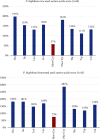Protein Quality of African Locust Bean-A High-Value Gathered Tree Food Contributing Protein and Palatability to Plant-Based Diets
- PMID: 39228903
- PMCID: PMC11371448
- DOI: 10.1155/2024/1596212
Protein Quality of African Locust Bean-A High-Value Gathered Tree Food Contributing Protein and Palatability to Plant-Based Diets
Abstract
The African locust bean tree Parkia biglobosa (Jacq.) R.Br. ex G. Don is a leguminous species native to the Sudanian parkland of western Africa. The seed obtained from pods collected from trees by rural women is fermented into a dense and aromatic paste known as soumbala, dawadawa, or iru-a protein-rich condiment underlying much of West African cuisine, its rich umami base lending a depth of flavor as a "meat substitute" in plant-based diets for which animal protein is a limiting component. Here, we assess the protein quality of P. biglobosa seed and its fermented product (soumbala) from three locations of southern Mali comprising three different eco-climatic zones, to determine whether variation in nutritional composition and protein quality could be correlated with the geographic variables of latitude and elevation. Proximate composition was determined, and amino acid profiles were compiled for 19 amino acids, with results compared by location and eco-climatic zone. A protein quality test was conducted in the aggregate and for each zone using the WHO/FAO Protein Digestibility-Corrected Amino Acid Score (PDCAAS) method. Principal component analysis (PCA) was used to assess patterns of amino acid compositional variation between the three origins. The results underline the nutritional significance of African locust bean as a source of dietary protein and of a depth of flavor providing enhanced palatability to plant-based diets. Although the PCA biplot for the amino acid profiles does indicate geographic clustering, the variation in nutritional composition and protein quality is insignificant for the raw seed, but highly significant for the fermented product (soumbala). The results indicate no correlation between phytochemical parameters and geographic variables of latitude and elevation, suggesting that management and processing may contribute more to nutritional quality than product provenance. Further studies should assess specific processing methods and the ambient microbiome as factors contributing to protein quality.
Keywords: flavor compounds; nitrogen conversion factor; palatability; plant proteins; umami.
Copyright © 2024 Eliot T. Masters and Bokary Allaye Kelly.
Conflict of interest statement
The authors declare no conflicts of interest.
Figures
References
-
- Hall J. B., Tomlinson H. F., Oni P. I., Buchy M., Aebischer D. P. School of agricultural and forest sciences publication . Bangor: University of Wales; 1997. Parkia biglobosa: a monograph.
-
- Pullan R. A. Farmed parkland in West Africa. Savanna . 1974;3(2):119–151.
-
- Boffa J. M. Agroforestry Parklands in Sub-Saharan Africa . Rome: FAO; 1999.
-
- Seignobos C. Matières grasses, parcs et civilisations agraires (Tchad et Nord-Cameroun) Les cahiers d'outre-mer . 1982;35(139):229–269.
-
- Dawson I. K., Leakey R., Clement C. R., et al. The management of tree genetic resources and the livelihoods of rural communities in the tropics: non-timber forest products, smallholder agroforestry practices and tree commodity crops. Forest Ecology and Management . 2014;333:9–21. doi: 10.1016/j.foreco.2014.01.021. - DOI
LinkOut - more resources
Full Text Sources





